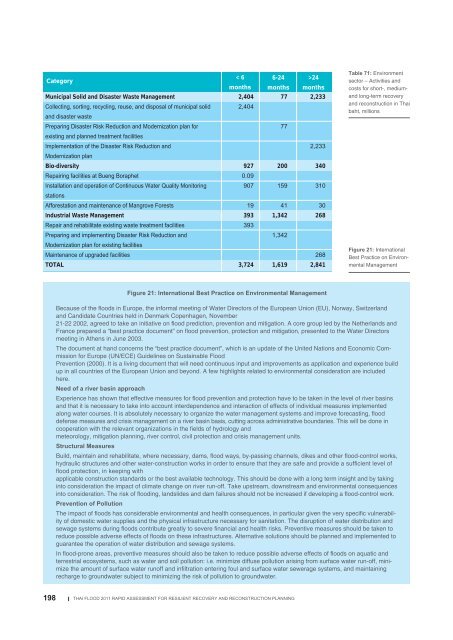Rapid Assessment for Resilient Recovery and ... - GFDRR
Rapid Assessment for Resilient Recovery and ... - GFDRR
Rapid Assessment for Resilient Recovery and ... - GFDRR
Create successful ePaper yourself
Turn your PDF publications into a flip-book with our unique Google optimized e-Paper software.
Category<br />
Municipal Solid <strong>and</strong> Disaster Waste Management<br />
Collecting, sorting, recycling, reuse, <strong>and</strong> disposal of municipal solid<br />
<strong>and</strong> disaster waste<br />
Preparing Disaster Risk Reduction <strong>and</strong> Modernization plan <strong>for</strong><br />
existing <strong>and</strong> planned treatment facilities<br />
Implementation of the Disaster Risk Reduction <strong>and</strong><br />
Modernization plan<br />
Bio-diversity<br />
Repairing facilities at Bueng Boraphet<br />
Installation <strong>and</strong> operation of Continuous Water Quality Monitoring<br />
stations<br />
Af<strong>for</strong>estation <strong>and</strong> maintenance of Mangrove Forests<br />
Industrial Waste Management<br />
Repair <strong>and</strong> rehabilitate existing waste treatment facilities<br />
Preparing <strong>and</strong> implementing Disaster Risk Reduction <strong>and</strong><br />
Modernization plan <strong>for</strong> existing facilities<br />
Maintenance of upgraded facilities<br />
TOTAL<br />
< 6<br />
months<br />
2,404<br />
2,404<br />
6-24<br />
months<br />
77<br />
>24<br />
months<br />
2,233<br />
Table 71: Environment<br />
sector – Activities <strong>and</strong><br />
costs <strong>for</strong> short-, medium<strong>and</strong><br />
long-term recovery<br />
<strong>and</strong> reconstruction in Thai<br />
baht, millions<br />
77<br />
2,233<br />
927<br />
0.09<br />
907<br />
200<br />
340<br />
159<br />
310<br />
19<br />
393<br />
393<br />
41<br />
30<br />
1,342<br />
268<br />
1,342<br />
3,724<br />
1,619<br />
268<br />
2,841<br />
Figure 21: International<br />
Best Practice on Environmental<br />
Management<br />
Figure 21: International Best Practice on Environmental Management<br />
Because of the floods in Europe, the in<strong>for</strong>mal meeting of Water Directors of the European Union (EU), Norway, Switzerl<strong>and</strong><br />
<strong>and</strong> C<strong>and</strong>idate Countries held in Denmark Copenhagen, November<br />
21-22 2002, agreed to take an initiative on flood prediction, prevention <strong>and</strong> mitigation. A core group led by the Netherl<strong>and</strong>s <strong>and</strong><br />
France prepared a “best practice document” on flood prevention, protection <strong>and</strong> mitigation, presented to the Water Directors<br />
meeting in Athens in June 2003.<br />
The document at h<strong>and</strong> concerns the “best practice document”, which is an update of the United Nations <strong>and</strong> Economic Commission<br />
<strong>for</strong> Europe (UN/ECE) Guidelines on Sustainable Flood<br />
Prevention (2000). It is a living document that will need continuous input <strong>and</strong> improvements as application <strong>and</strong> experience build<br />
up in all countries of the European Union <strong>and</strong> beyond. A few highlights related to environmental consideration are included<br />
here.<br />
Need of a river basin approach<br />
Experience has shown that effective measures <strong>for</strong> flood prevention <strong>and</strong> protection have to be taken in the level of river basins<br />
<strong>and</strong> that it is necessary to take into account interdependence <strong>and</strong> interaction of effects of individual measures implemented<br />
along water courses. It is absolutely necessary to organize the water management systems <strong>and</strong> improve <strong>for</strong>ecasting, flood<br />
defense measures <strong>and</strong> crisis management on a river basin basis, cutting across administrative boundaries. This will be done in<br />
cooperation with the relevant organizations in the fields of hydrology <strong>and</strong><br />
meteorology, mitigation planning, river control, civil protection <strong>and</strong> crisis management units.<br />
Structural Measures<br />
Build, maintain <strong>and</strong> rehabilitate, where necessary, dams, flood ways, by-passing channels, dikes <strong>and</strong> other flood-control works,<br />
hydraulic structures <strong>and</strong> other water-construction works in order to ensure that they are safe <strong>and</strong> provide a sufficient level of<br />
flood protection, in keeping with<br />
applicable construction st<strong>and</strong>ards or the best available technology. This should be done with a long term insight <strong>and</strong> by taking<br />
into consideration the impact of climate change on river run-off. Take upstream, downstream <strong>and</strong> environmental consequences<br />
into consideration. The risk of flooding, l<strong>and</strong>slides <strong>and</strong> dam failures should not be increased if developing a flood-control work.<br />
Prevention of Pollution<br />
The impact of floods has considerable environmental <strong>and</strong> health consequences, in particular given the very specific vulnerability<br />
of domestic water supplies <strong>and</strong> the physical infrastructure necessary <strong>for</strong> sanitation. The disruption of water distribution <strong>and</strong><br />
sewage systems during floods contribute greatly to severe financial <strong>and</strong> health risks. Preventive measures should be taken to<br />
reduce possible adverse effects of floods on these infrastructures. Alternative solutions should be planned <strong>and</strong> implemented to<br />
guarantee the operation of water distribution <strong>and</strong> sewage systems.<br />
In flood-prone areas, preventive measures should also be taken to reduce possible adverse effects of floods on aquatic <strong>and</strong><br />
terrestrial ecosystems, such as water <strong>and</strong> soil pollution: i.e. minimize diffuse pollution arising from surface water run-off, minimize<br />
the amount of surface water runoff <strong>and</strong> infiltration entering foul <strong>and</strong> surface water sewerage systems, <strong>and</strong> maintaining<br />
recharge to groundwater subject to minimizing the risk of pollution to groundwater.<br />
198 THAI FLOOD 2011 RAPID ASSESSMENT FOR RESILIENT RECOVERY AND RECONSTRUCTION PLANNING

















